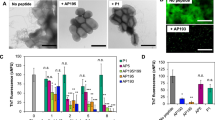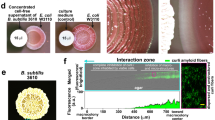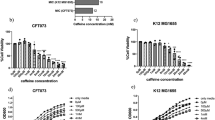Abstract
Curli are functional extracellular amyloid fibers produced by uropathogenic Escherichia coli (UPEC) and other Enterobacteriaceae. Ring-fused 2-pyridones, such as FN075 and BibC6, inhibited curli biogenesis in UPEC and prevented the in vitro polymerization of the major curli subunit protein CsgA. The curlicides FN075 and BibC6 share a common chemical lineage with other ring-fused 2-pyridones termed pilicides. Pilicides inhibit the assembly of type 1 pili, which are required for pathogenesis during urinary tract infection. Notably, the curlicides retained pilicide activities and inhibited both curli-dependent and type 1–dependent biofilms. Furthermore, pretreatment of UPEC with FN075 significantly attenuated virulence in a mouse model of urinary tract infection. Curli and type 1 pili exhibited exclusive and independent roles in promoting UPEC biofilms, and curli provided a fitness advantage in vivo. Thus, the ability of FN075 to block the biogenesis of both curli and type 1 pili endows unique anti-biofilm and anti-virulence activities on these compounds.
This is a preview of subscription content, access via your institution
Access options
Subscribe to this journal
Receive 12 print issues and online access
$259.00 per year
only $21.58 per issue
Buy this article
- Purchase on Springer Link
- Instant access to full article PDF
Prices may be subject to local taxes which are calculated during checkout





Similar content being viewed by others
References
Costerton, J.W., Lewandowski, Z., Caldwell, D.E., Korber, D.R. & Lappin-Scott, H.M. Microbial biofilms. Annu. Rev. Microbiol. 49, 711–745 (1995).
Ryu, J.H. & Beuchat, L.R. Biofilm formation by Escherichia coli O157:H7 on stainless steel: effect of exopolysaccharide and Curli production on its resistance to chlorine. Appl. Environ. Microbiol. 71, 247–254 (2005).
Olsen, A., Jonsson, A. & Normark, S. Fibronectin binding mediated by a novel class of surface organelles on Escherichia coli. Nature 338, 652–655 (1989).
Chapman, M.R. et al. Role of Escherichia coli curli operons in directing amyloid fiber formation. Science 295, 851–855 (2002).
Barnhart, M.M. & Chapman, M.R. Curli biogenesis and function. Annu. Rev. Microbiol. 60, 131–147 (2006).
Cegelski, L., Smith, C.L. & Hulgren, S.J. Microbial adhesion. in Encyclopedia of Microbiology (ed. Schaechter, M.) 1–10 (Academic Press, New York, 2009).
Uhlich, G.A., Cooke, P.H. & Solomon, E.B. Analyses of the red-dry-rough phenotype of an Escherichia coli O157:H7 strain and its role in biofilm formation and resistance to antibacterial agents. Appl. Environ. Microbiol. 72, 2564–2572 (2006).
Kikuchi, T., Mizunoe, Y., Takade, A., Naito, S. & Yoshida, S. Curli fibers are required for development of biofilm architecture in Escherichia coli K-12 and enhance bacterial adherence to human uroepithelial cells. Microbiol. Immunol. 49, 875–884 (2005).
Zogaj, X., Bokranz, W., Nimtz, M. & Romling, U. Production of cellulose and curli fimbriae by members of the family Enterobacteriaceae isolated from the human gastrointestinal tract. Infect. Immun. 71, 4151–4158 (2003).
Parsek, M.R. & Singh, P.K. Bacterial biofilms: an emerging link to disease pathogenesis. Annu. Rev. Microbiol. 57, 677–701 (2003).
Donlan, R.M. & Costerton, J.W. Biofilms: survival mechanisms of clinically relevant microorganisms. Clin. Microbiol. Rev. 15, 167–193 (2002).
Larsen, P. et al. Amyloid adhesins are abundant in natural biofilms. Environ. Microbiol. 9, 3077–3090 (2007).
Larsen, P., Nielsen, J.L., Otzen, D. & Nielsen, P.H. Amyloid-like adhesins produced by floc-forming and filamentous bacteria in activated sludge. Appl. Environ. Microbiol. 74, 1517–1526 (2008).
Branda, S.S., Vik, S., Friedman, L. & Kolter, R. Biofilms: the matrix revisited. Trends Microbiol. 13, 20–26 (2005).
Sauer, F.G., Mulvey, M.A., Schilling, J.D., Martinez, J.J. & Hultgren, S.J. Bacterial pili: molecular mechanisms of pathogenesis. Curr. Opin. Microbiol. 3, 65–72 (2000).
Anderson, G.G. et al. Intracellular bacterial biofilm-like pods in urinary tract infections. Science 301, 105–107 (2003).
Justice, S.S. et al. Differentiation and developmental pathways of uropathogenic Escherichia coli in urinary tract pathogenesis. Proc. Natl. Acad. Sci. USA 101, 1333–1338 (2004).
Wright, K.J., Seed, P.C. & Hultgren, S.J. Development of intracellular bacterial communities of uropathogenic Escherichia coli depends on type 1 pili. Cell. Microbiol. 9, 2230–2241 (2007).
Aberg, V. & Almqvist, F. Pilicides-small molecules targeting bacterial virulence. Org. Biomol. Chem. 5, 1827–1834 (2007).
Reisner, A., Haagensen, J.A., Schembri, M.A., Zechner, E.L. & Molin, S. Development and maturation of Escherichia coli K-12 biofilms. Mol. Microbiol. 48, 933–946 (2003).
Pratt, L.A. & Kolter, R. Genetic analysis of Escherichia coli biofilm formation: roles of flagella, motility, chemotaxis and type 1 pili. Mol. Microbiol. 30, 285–293 (1998).
Saldana, Z. et al. Synergistic role of curli and cellulose in cell adherence and biofilm formation of attaching and effacing Escherichia coli and identification of Fis as a negative regulator of curli. Environ. Microbiol. 11, 992–1006 (2009).
Cegelski, L., Marshall, G.R., Eldridge, G.R. & Hultgren, S.J. The biology and future prospects of antivirulence therapies. Nat. Rev. Microbiol. 6, 17–27 (2008).
Pinkner, J.S. et al. Rationally designed small compounds inhibit pilus biogenesis in uropathogenic bacteria. Proc. Natl. Acad. Sci. USA 103, 17897–17902 (2006).
Emtenas, H., Alderin, L. & Almqvist, F. An enantioselective ketene-imine cycloaddition method for synthesis of substituted ring-fused 2-pyridinones. J. Org. Chem. 66, 6756–6761 (2001).
Emtenas, H., Taflin, C. & Almqvist, F. Efficient microwave assisted synthesis of optically active bicyclic 2-pyridinones via delta2-thiazolines. Mol. Divers. 7, 165–169 (2003).
Jones, C.H. et al. FimC is a periplasmic PapD-like chaperone that directs assembly of type 1 pili in bacteria. Proc. Natl. Acad. Sci. USA 90, 8397–8401 (1993).
Hung, D.L. & Hultgren, S.J. Pilus biogenesis via the chaperone/usher pathway: an integration of structure and function. J. Struct. Biol. 124, 201–220 (1998).
Aberg, V. et al. Microwave-assisted decarboxylation of bicyclic 2-pyridone scaffolds and identification of Abeta-peptide aggregation inhibitors. Org. Biomol. Chem. 3, 2817–2823 (2005).
Robinson, L.S., Ashman, E.M., Hultgren, S.J. & Chapman, M.R. Secretion of curli fibre subunits is mediated by the outer membrane-localized CsgG protein. Mol. Microbiol. 59, 870–881 (2006).
Hammar, M., Bian, Z. & Normark, S. Nucleator-dependent intercellular assembly of adhesive curli organelles in Escherichia coli. Proc. Natl. Acad. Sci. USA 93, 6562–6566 (1996).
Nenninger, A.A., Robinson, L.S. & Hultgren, S.J. Localized and efficient curli nucleation requires the chaperone-like amyloid assembly protein CsgF. Proc. Natl. Acad. Sci. USA 106, 900–905 (2009).
Olsen, A., Arnqvist, A., Hammar, M. & Normark, S. Environmental regulation of curli production in Escherichia coli. Infect. Agents Dis. 2, 272–274 (1993).
Zogaj, X., Nimtz, M., Rohde, M., Bokranz, W. & Romling, U. The multicellular morphotypes of Salmonella typhimurium and Escherichia coli produce cellulose as the second component of the extracellular matrix. Mol. Microbiol. 39, 1452–1463 (2001).
O'Toole, G.A. & Kolter, R. Initiation of biofilm formation in Pseudomonas fluorescens WCS365 proceeds via multiple, convergent signalling pathways: a genetic analysis. Mol. Microbiol. 28, 449–461 (1998).
Rosen, D.A. et al. Molecular variations in Klebsiella pneumoniae and Escherichia coli FimH affect function and pathogenesis in the urinary tract. Infect. Immun. 76, 3346–3356 (2008).
Garofalo, C.K. et al. Escherichia coli from urine of female patients with urinary tract infections is competent for intracellular bacterial community formation. Infect. Immun. 75, 52–60 (2007).
Beloin, C., Roux, A. & Ghigo, J.M. Escherichia coli biofilms. Curr. Top. Microbiol. Immunol. 322, 249–289 (2008).
Justice, S.S., Lauer, S.R., Hultgren, S.J. & Hunstad, D.A. Maturation of intracellular Escherichia coli communities requires SurA. Infect. Immun. 74, 4793–4800 (2006).
Keith, C.T., Borisy, A.A. & Stockwell, B.R. Multicomponent therapeutics for networked systems. Nat. Rev. Drug Discov. 4, 71–78 (2005).
Martinez, J.J., Mulvey, M.A., Schilling, J.D., Pinkner, J.S. & Hultgren, S.J. Type 1 pilus-mediated bacterial invasion of bladder epithelial cells. EMBO J. 19, 2803–2812 (2000).
Duncan, M.J., Li, G., Shin, J.S., Carson, J.L. & Abraham, S.N. Bacterial penetration of bladder epithelium through lipid rafts. J. Biol. Chem. 279, 18944–18951 (2004).
Terada, N. et al. Involvement of dynamin-2 in formation of discoid vesicles in urinary bladder umbrella cells. Cell Tissue Res. 337, 91–102 (2009).
Dhakal, B.K. & Mulvey, M.A. Uropathogenic Escherichia coli invades host cells via an HDAC6-modulated microtubule-dependent pathway. J. Biol. Chem. 284, 446–454 (2009).
Bishop, B.L. et al. Cyclic AMP-regulated exocytosis of Escherichia coli from infected bladder epithelial cells. Nat. Med. 13, 625–630 (2007).
Mulvey, M.A. et al. Induction and evasion of host defenses by type 1-piliated uropathogenic Escherichia coli. Science 282, 1494–1497 (1998).
Lloyd, A.L., Henderson, T.A., Vigil, P.D. & Mobley, H.L. Genomic islands of uropathogenic Escherichia coli contribute to virulence. J. Bacteriol. 191, 3469–3481 (2009).
Wright, K.J., Seed, P.C. & Hultgren, S.J. Uropathogenic Escherichia coli flagella aid in efficient urinary tract colonization. Infect. Immun. 73, 7657–7668 (2005).
Hammer, N.D., Wang, X., McGuffie, B.A. & Chapman, M.R. Amyloids: friend or foe? J. Alzheimers Dis. 13, 407–419 (2008).
Badtke, M.P., Hammer, N.D. & Chapman, M.R. Functional amyloids signal their arrival. Sci. Signal. 2, pe43 (2009).
Acknowledgements
We gratefully acknowledge the expertise of W. Beatty (Imaging Facility, Washington University School of Medicine) and of A. Olofsson (Umeå Centre for Molecular Pathogenesis, Umeå University). This study was supported in part by the Swedish Natural Science Research Council and the Knut and Alice Wallenberg Foundation. The authors acknowledge funding from the US National Institutes of Health to S.J.H. (AI02549, AI048689, AI049950 and P50 DK64540), M.R.C. (AI073847), P.C.S. (K12HD00850 and K08DK074443) and L.C. (T32A107172). L.C. holds a Career Award at the Scientific Interface from the Burroughs Wellcome Fund.
Author information
Authors and Affiliations
Contributions
L.C., J.S.P., N.D.H., C.K.C. and C.S.H. performed and analyzed experiments. E.C. and V.A. synthesized and characterized the molecules. L.C., J.S.P., F.A. and S.J.H. conceptualized and initiated the project. M.R.C., F.A. and S.J.H. oversaw the project and assisted in data analysis. P.C.S. prepared critical reagents. L.C., J.S.P., M.R.C., F.A., C.K.C. and S.J.H. contributed to writing the manuscript. All authors read and edited the manuscript.
Corresponding authors
Supplementary information
Supplementary Text and Figures
Supplementary Figures 1 and 2, and Supplementary Methods (PDF 435 kb)
Rights and permissions
About this article
Cite this article
Cegelski, L., Pinkner, J., Hammer, N. et al. Small-molecule inhibitors target Escherichia coli amyloid biogenesis and biofilm formation. Nat Chem Biol 5, 913–919 (2009). https://doi.org/10.1038/nchembio.242
Received:
Accepted:
Published:
Issue Date:
DOI: https://doi.org/10.1038/nchembio.242
This article is cited by
-
Biofilm and wound healing: from bench to bedside
European Journal of Medical Research (2023)
-
Using next generation antimicrobials to target the mechanisms of infection
npj Antimicrobials and Resistance (2023)
-
Designed α-sheet peptides disrupt uropathogenic E. coli biofilms rendering bacteria susceptible to antibiotics and immune cells
Scientific Reports (2023)
-
Identification of natural diterpenes isolated from Azorella species targeting dispersin B using in silico approaches
Journal of Molecular Modeling (2023)
-
Small molecule targeting amyloid fibrils inhibits Streptococcus mutans biofilm formation
AMB Express (2021)



